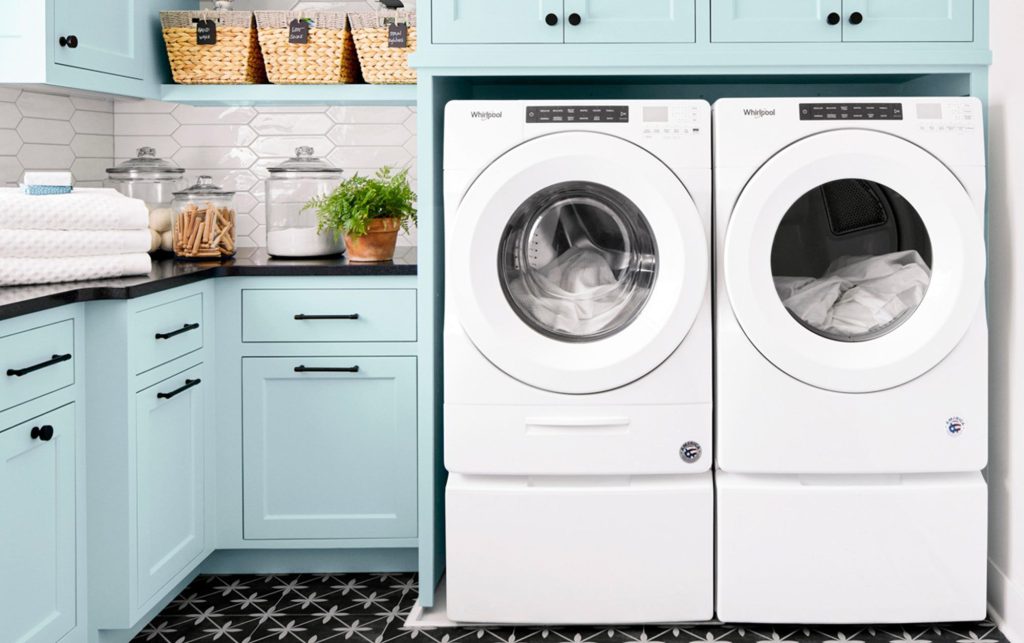:max_bytes(150000):strip_icc():format(jpeg)/white-washer-dryer-laundry-room-3qFEyeFWKlR9vfOBKJNVZo-V2-2000-5b9da3425b124680966a25a3866287a6.jpg)
Homeowners who have never had to scramble to find a fire extinguisher or douse a growing fire with a hastily gathered bucket of water might underestimate the risks fire poses. House fires can cause immediate harm, but they can also leave you with lingering debt as you manage the financial repercussions. To protect yourself, your family, your pets, and your home, it’s essential to identify which appliances, products, and areas of the home pose a fire risk.
The 10 Largest Fire Threats in Your Home
Use this guide to discover which household items are the largest fire threats to you and your family, and what to do about them.
1. Unattended Pans
Cooking and baking are a regular part of everyday life, but the oven and stove can be incredibly hazardous when used improperly. Unattended pans and baking sheets pose a significant fire threat to the home, as the contents of the pot or pan could burn or spill over the edge and onto a burner. Cooking oil and grease can quickly ignite when exposed to high temperatures, leading to a grease fire that can spread to the rest of the kitchen.
It’s easy to reduce the risk of fire due to unattended cooking by simply staying close to the stove so you can take immediate action if something happens. You should keep flammable materials away from the oven and stovetop, such as towels, cloths, and paper products, like napkins and paper plates. It’s also important to have an appropriately rated fire extinguisher in a readily accessible location in the kitchen for emergencies.
2. Clothes Dryer
Generally, any appliance that generates a significant amount of heat can pose a fire risk to the home. However, clothes dryers are typically safe to use when properly maintained. The problem occurs when the clothes dryer is neglected, allowing lint to build up inside the lint trap and dryer vents. Since lint is essentially a collection of tiny cloth fibers, it makes sense that these fibers might ignite when exposed to high heat for an extended period.
To prevent this from happening, clean the clothes dryer lint trap before and after every use. This promotes better airflow, allowing your dryer to operate more efficiently. You should also clean the dryer vent every few months and have the dryer inspected annually by a professional, so that you can identify any potential problems before they occur.
3. Faulty Wiring
Electrical systems run throughout the home and connect to a wide variety of appliances and devices, allowing you to make full use of electricity, regardless of which room you are in. However, faulty wiring, overloaded circuits, damaged outlets, and even regular use of the electrical system can put a home at risk of a fire.
For this reason, it’s necessary to hire an electrician to make repairs to any damaged electrical components or faulty wiring as soon as possible. Look out for signs of faulty wiring, such as flickering lights or discolored outlets, and be sure to read the warning labels and care instructions for your appliances and devices before using them. You should also regularly clean dust away from any heat sources or electrical outlets since accumulated dust can ignite, especially in enclosed spaces, like the basement or attic.
4. Overloaded Power Strips
Power strips provide the opportunity to plug in more devices than would normally be possible with a standard outlet. However, having more space to plug in items doesn’t mean the circuit can handle the increased electrical demand. Using a power strip to power multiple appliances can cause the circuit to overload. The excess heat produced by the overloaded circuit can lead to a fire.
To mitigate this risk, it’s essential to have a basic understanding of the power requirements of each connected device, allowing you to reduce the number of high-demand appliances and electrical devices connected if needed. Additionally, it’s a good idea to invest in a power strip with surge and overload protection and to unplug your electronics when they are not in use, or at the very least, turn off the power strip.
5. Space Heaters
Space heaters are ideal for heating a single room in the home, rather than forcing the furnace to work harder to increase the temperature throughout the entire house. They are a great way to save on electricity and improve personal comfort levels, but if these appliances are not correctly set up, operated, and maintained, they increase the risk of fire.
When using a space heater, ensure the area is clear of dust, hair, and other flammable debris. You should also keep any flammable items at least three feet away from the space heater, including bedding, curtains, or carpeting. Additionally, it’s essential to turn the space heater off when you leave the home or go to sleep, and never leave it unattended.
6. Candles
Setting up one or more scented candles can be a great way to help relax and unwind at home, but it’s important to place the candle in a safe location and on a stable surface to reduce the risk of spreading the fire from the lit wick to any nearby flammable materials, like curtains, furniture, bedding, or carpets.
You should also never leave a lit candle unattended, even if it is set up in a relatively safe spot. Accidents can occur when you least expect them, like a strong breeze from an open window blowing a curtain within range of a lit flame. With this in mind, keep lit candles within view at all times and put them out when you leave the room. Take care to ensure that they are completely out, as even a smoking wick can reignite under the right circumstances.
7. Smoking
Smoking is one of the most common risks of household fires, primarily due to the carelessness of the individual who is smoking. Never smoke in bed or anywhere indoors, because the smoke can fill up the space and seep into your furniture, carpet, and other fabrics. Not only does this make the home smell like smoke, but smoking in the vicinity of these flammable materials also increases the risk of fire.
Similarly, if you are smoking outdoors, you need to be careful about where you hold the smoking materials, where you discard them, and how you dispose of them. Ideally, you should have a fireproof ashtray sitting on a flat, solid surface. Position the ashtray at least three feet from any flammable materials, including the house itself, and always make sure the cigarettes, cigars, pipes, or other smoking materials are fully extinguished when you finish using them.
8. Flammable Liquids and Chemicals
There is an obvious reason why flammable liquids and chemicals, such as cleaning solutions, gasoline, and aerosol products, have printed warning labels and handling instructions. If you ignore these warnings and directions, you might put your home at risk of accidental fire.
Even when storing flammable liquids or chemicals, follow the manufacturer’s directions to determine safe locations around the home for these products. For instance, you should never store aerosols on a sunny windowsill, as the heat from the sun could cause them to explode. Similarly, a can of gasoline for the lawn mower should be kept in an appropriate container and stored in a cool, dry area away from any possible heat sources.
9. Christmas Lights and Decorations
It’s normal to see homeowners running a string of Christmas lights around the tree, putting lights on the house, and setting up a variety of decorations throughout the home and yard to celebrate the holiday season. However, these decorations can pose a serious fire risk if they are not properly installed, monitored, and maintained.
To minimize the risk of fire, avoid running cords under rugs or carpeting, ensure you are using the correct light bulbs, and refrain from using cords with unprotected or frayed wires. Additionally, limit the amount of extension cords you use, and regularly water live trees to prevent them from drying out. Unplug the Christmas lights and any other decorations when you are not at home to prevent damage.
10. Fireplaces and Chimneys
The fireplace is designed to contain open flames and vent the smoke produced by the burning wood through the chimney. However, some people decide to get creative with their fires, using chemicals like gasoline, kerosene, or charcoal starter to ignite the fire. Additionally, many homeowners neglect to clean the chimney regularly, which can lead to creosote buildup.
When using a fireplace, keep the area around it free of flammable objects and avoid starting the fire with chemical products. Ensure that you are using dry wood, as wet wood can increase the amount of soot buildup in the chimney. Have your fireplace and chimney inspected and cleaned about once a year, so that creosote doesn’t accumulate to a dangerous level.

